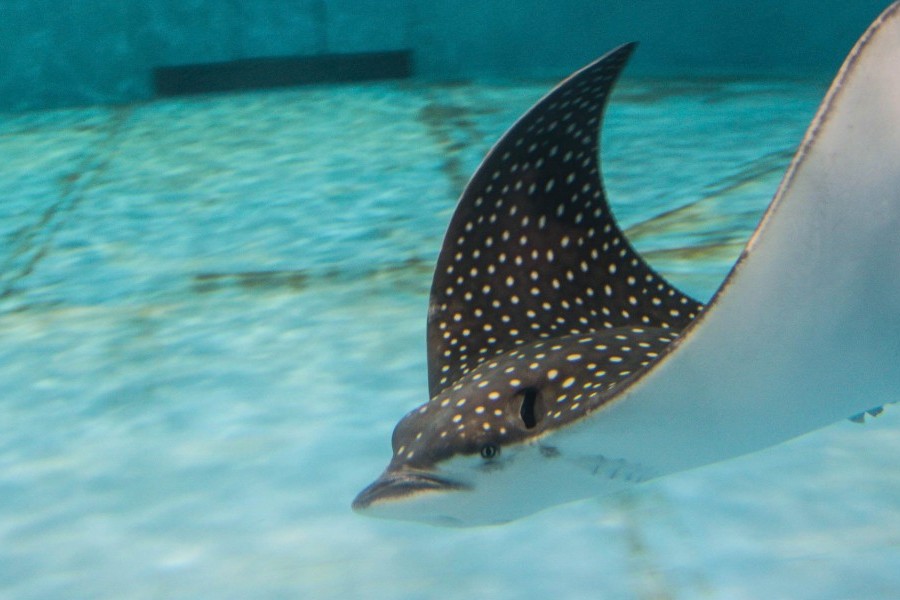Mote and Georgia Aquarium team up for ray research and Youth Making Ripples panel discussion tonight
This week, Mote Marine Laboratory’s Staff Scientist, Kim Bassos-Hull, and Georgia Aquarium’s Nutritionist and Researcher, Dr. Lisa Hoopes, are conducting routine health assessments of spotted eagle rays in Sarasota County.
Tonight, Sept. 28, the two researchers will participate in a panel discussion and mini-film screening during the "Youth Making Ripples" Film Competition at Mote in Sarasota. Details below.
Since the inception of Mote’s Spotted Eagle Ray Conservation Program in 2009, Mote scientists have fitted about 540 spotted eagle rays with passive integrated transponder tags and 14 of those with acoustic tags in an effort to learn more about their life history, reproduction and population status in the first-ever comprehensive spotted eagle ray conservation project in the Gulf of Mexico.
So far, Mote scientists have learned that the Sarasota area hosts all size classes of spotted eagle rays from babies (pups) to adults. Some rays stay in the area or return after months to years. Some pups are born in the late summer and early fall, and the rays move or migrate to other locations in winter months when local waters are too cold.
Mote scientists have also noted a declining then stabilizing trend in numbers of rays observed in aerial and boat surveys, which indicates a need for continued monitoring of this species’ status.
Because there is not enough information about the distribution, migration, feeding habits, growth rates and reproductive biology of spotted eagle rays, Mote researchers initiated a multi-collaborative conservation research project in 2009, including Georgia Aquarium in Atlanta, a major supporter of the program.
“With the help of many organizations, including Georgia Aquarium, we have been the first to document population status reports of spotted eagle rays in the Gulf of Mexico,” Bassos-Hull said. “This information is important, because these rays are a good indicator of the overall ecosystem. The more we know about them, the more we know about the overall ecosystem’s health.”
Other collaborators include California Academy of Sciences in San Francisco; El Colegio de la Frontera Sur (ECOSUR) in Campeche, Mexico; Harbor Branch/Florida Atlantic University in Ft. Pierce; University of Havana’s Center for Marine Research in Havana, Cuba; and University of South Florida Sarasota-Manatee.
This conservation project began with support from the National Aquarium in Baltimore, but has since expanded into a full research program with supporters including Georgia Aquarium, the Disney Worldwide Conservation Fund and the Save Our Seas Foundation.
Mercury Marine, which has been making world-class outboards and sterndrives for more than 75 years, is also a major supporter of this research project. They donated a large portion of the cost of the engine to operate the Ono V boat Mote uses for this research project.
This week, Hoopes joins Bassos-Hull, for a health assessment of spotted eagles rays in Sarasota County waters.
To learn more about this research, join Bassos-Hull and Hoopes for a mini film screening and panel discussion during the "Youth Making Ripples" Film Competition at 6-7:30 p.m. tonight, Wednesday, Sept. 28, in Mote's WAVE Center, 1600 Ken Thompson Parkway on City Island, Sarasota.
Unfortunately, this event has passed. Please click here to see upcoming events at Mote.
This film competition, organized by Beneath the Waves, Inc., gives students in grades K-12 the chance to use their creative talents to give the oceans a voice.
Beneath the Waves, Inc., a global platform focusing on ocean conservation, education and discovery, works to raise awareness about marine issues, foster the advancement of science and promote the protection of our oceans.
The panel of science experts that will be speaking at the event are:
- Kim Bassos-Hull, Senior Biologist, Mote Marine Laboratory
- Dr. Lisa Hoopes, Nutritionist and Researcher, Georgia Aquarium
- Krystan Wilkinson, Graduate Student, Sarasota Dolphin Research Program
